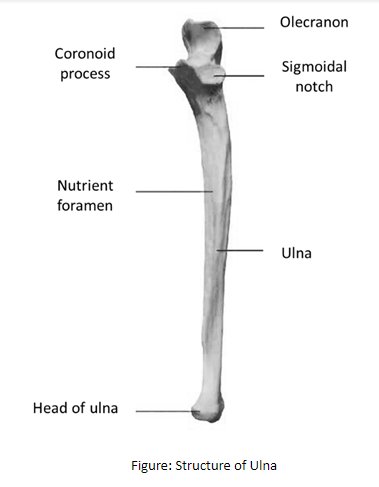
Sigmoid notch is present in
(a)Radius
(b)Ulna
(c)Humerus
(d)Femur
Answer
571.5k+ views
Hint: It is a long bone found in the forearm that runs parallel to the radius. The bone forms the elbow joint with the humerus. It also articulates with the radius of both proximally and distally.
Complete answer:
The sigmoid notch is present in the ulna and is commonly called a radial notch. This notch is present on the head of the Ulna forming the distal radioulnar joint. The sigmoid notch is a narrow, oblong, articular depression on the lateral side of the coronoid process. This bone is the stable unit of the forearm and supports the loads conveyed from the radius and carpus. The head of the ulna serves as the articular surface for the sigmoid notch around which the radius rotates. The ulnar head surface that faces the sigmoidal notch forms a slightly asymmetric, partial cylinder of about a 130-degree arc.
Additional Information:
-The ulna is generally slightly longer than the radius, but the radius is thicker.
-It has two curved processes, the olecranon, and the coronoid process.
-The olecranon is a hook-like structure that fits into the olecranon fossa of the humerus and forms the upper part of the semilunar notch.
-The coronoid process is triangular importance which is projecting forward from the upper and front part of the ulna.
-The semilunar notch serves as an articulation with the trochlea of the humerus.
Note: -A flat sigmoid notch is more prone to instability and less responsive to treatment by soft tissue repair bone.
-The head of the ulna is the lateral and distal end of the ulna which articulates with the ulnar notch on the radius and with the triangular articular disc in the Wrist Joint.
-The elbow joint can also be affected like other bones by osteoarthritis in the elbow joints.

Complete answer:
The sigmoid notch is present in the ulna and is commonly called a radial notch. This notch is present on the head of the Ulna forming the distal radioulnar joint. The sigmoid notch is a narrow, oblong, articular depression on the lateral side of the coronoid process. This bone is the stable unit of the forearm and supports the loads conveyed from the radius and carpus. The head of the ulna serves as the articular surface for the sigmoid notch around which the radius rotates. The ulnar head surface that faces the sigmoidal notch forms a slightly asymmetric, partial cylinder of about a 130-degree arc.
Additional Information:
-The ulna is generally slightly longer than the radius, but the radius is thicker.
-It has two curved processes, the olecranon, and the coronoid process.
-The olecranon is a hook-like structure that fits into the olecranon fossa of the humerus and forms the upper part of the semilunar notch.
-The coronoid process is triangular importance which is projecting forward from the upper and front part of the ulna.
-The semilunar notch serves as an articulation with the trochlea of the humerus.
Note: -A flat sigmoid notch is more prone to instability and less responsive to treatment by soft tissue repair bone.
-The head of the ulna is the lateral and distal end of the ulna which articulates with the ulnar notch on the radius and with the triangular articular disc in the Wrist Joint.
-The elbow joint can also be affected like other bones by osteoarthritis in the elbow joints.

Recently Updated Pages
Master Class 12 Business Studies: Engaging Questions & Answers for Success

Master Class 12 Economics: Engaging Questions & Answers for Success

Master Class 12 English: Engaging Questions & Answers for Success

Master Class 12 Maths: Engaging Questions & Answers for Success

Master Class 12 Social Science: Engaging Questions & Answers for Success

Master Class 12 Chemistry: Engaging Questions & Answers for Success

Trending doubts
What are the major means of transport Explain each class 12 social science CBSE

Which are the Top 10 Largest Countries of the World?

Draw a labelled sketch of the human eye class 12 physics CBSE

How much time does it take to bleed after eating p class 12 biology CBSE

Explain sex determination in humans with line diag class 12 biology CBSE

Differentiate between homogeneous and heterogeneous class 12 chemistry CBSE




